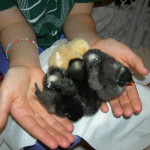Gentle Reader,
I depart from my usual commentary on health and fitness to give you a post on backyard chickens. My flock and my granddaughter’s Alicia’s flock have dominated our lives for the past couple weeks. Someone suggested I share the drama.
***
Her cry wrenches their hearts. Mid-range utterances, she tips her head back and repeats the call. She wanders around the garden, not searching for insects, pecking the ground, but looking, looking under the laurel where they laid their eggs in protest against the hen house, calling, calling in that forlorn voice. She comes to the back door, taps the window, one eye peering in. “Help me find her,” she seems to say. “My sister hen is gone.”
So simple, the pathos of a bereft chicken whose only companion has been taken off by a raccoon and eaten down to yellow feet and pile of feathers.
I get the call and make out what has happened through the tearful tale.
“No, we cannot bring a new companion hen into a back yard being stalked in broad daylight by a blood thirsty raccoon. She can come to my house to live with my 3 hens.”
We post this tragedy on Facebook. Within a few hours along with advice and condolences, comes a blog post written by a friend’s pastor at one of Seattle’s principle protestant churches. I read this post. My experience with chickens over my life is so far from the writer’s; I visualize the two flocks at opposite ends of Dante’s Inferno and Paradiso. She and her chickens have passed through the hairy flank of the Devil to the other side and now live with the white rose of heaven. My flock, ever recovering from confusion, violence, mayhem, mutilation, and death, represents life as we know it: ruled by attachment, greed and suffering. The pastor describes a small child who visited her well-ordered coop and reported that there were baby chicks out there. New birth is revealed to a child. The author had not seen them and did not believe the child’s report. Listen to the children, is her conclusion.
I began my urban farming in Seattle when my grandchildren were four-ish. We set up the nursery in the basement using an old playpen and plywood on top to prevent a cat snatch. The one-day old chicks fit into the cupped hands of my 7-year-old granddaughter. We started with six and in a few days had four. All that loving by 4 year olds proved too much for the chicks but provided an excellent opportunity for “softly, gently, quietly,” as if a four year old had a dimmer switch. They are either “on” full throttle, or “off” full stop.
The Pastor’s brooding hen gathered a small clutch of eggs, possibly all her own, and hatched them out, presumably without causing a stir. In my hen house, there are three nesting box platforms to accommodate four to six hens. All three of my current flock insists on roosting and laying in the highest, smallest platform. The gorgeous golden-flecked Americana went into brood-mood, spread her wings, and fluffed her feathers occupying the total footprint of that nesting shelf. Her rage at the other hens when they came to lay their eggs was so raucous; I rushed to the henhouse to investigate. The other two hens laid their eggs into thin air, whereupon they fell to the ground and cracked. My strong arms and hefty broom could not dislodge her from her roost. I called my grandson in Mt. Vernon, champion chicken-raiser. His advice was to separate her from the other two for a week.
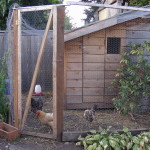
Lean-to with wire enclosure
I construct a wire enclosure alongside the hen house within the raccoon proof run. Three days in a row, like Houdini, she finds an opening and returns to the nesting platform. I put a playpen up on the other side of the garden, put water and food on the gravel, cover it with chicken wire and shake shingles to keep her dry. An unbelievable wailing and gnashing of hen’s beaks ensues as the three hens call to each other across the garden. At the end of the week, I pick Cana up and return her to the hen enclosure. Red (the top hen, a Rhode Island Red) attacks her with talons and beak,
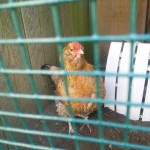
going for the head and neck. I stand in the coop sipping tea and talking down the high level of distress off and on for two days until everything calms down. Cana makes one more attempt to brood but the broom and a strong arm take her down quickly.
I am at a loss to find any beatific or holy lesson from this aggression, possessiveness and anxiety over separation. Perhaps the Israelites wandering in the wildness bad-mouthing Moses and getting all fussed about manna and hardship, but that would be stretching it and I would end playing the role of the all-powerful somewhat capricious Old Testament Jehovah.
Chickens have been in my life since childhood. My brother Eric and I raised a flock of day old Leghorn meat chicken to pullet stage as a 4H project. In 1950, American farmers enjoyed the first fruits of “better living through chemistry” with Purina’s “fortified” chicken food, antibiotics and growth hormones recommended to insure healthy and profitable growth. My parents, who had entered medicine before the Polio vaccine, penicillin or sulfa drugs, were on board with these measures published in the Dept. of Agriculture farm bulletins. Eric, twelve years old at the time, thought that if growth hormones were good for young chicks, they might be good for him, too, so he downed a vial of the liquid. I reported this at the dinner table. It caused not a stir. My father’s physician’s samples of every new pharmaceutical for whatever might ail you filled the largest drawer of the bathroom vanity. I have often wondered what the economic lesson was for us 4H-ers when we were paid the going market rate per pound for grown chickens, but were not required to deduct the costs involved in raising them.
Our first flock of pullets at our home in West Seattle lived in a coop constructed from a kit, built with many little grandchildren hands helping (priceless experience). The coop was too small. I sold it on Craig’s list (1/4 the original price), but not before hiring a carpenter to construct a lean-to against the garden shed. By the time the first eggs came along, my husband calculated that each of the first 4 dozen was worth $250. An expensive “eat local, eat slow food” project.
The most aggressive of the four woke us up one early Sunday morning with a cock-a doodle-do that raised the hairs on the back of my neck. My husband and I took one look at each other, went to church and the minute we returned, went to computer to ask Google, “how to kill a chicken.” Chuck found a method that involved neither an axe nor the wringing of necks.
Take the chicken by its feet; lay its head on the grass; place a broom handle across the neck; stand on the handle; jerk the feet, snapping the neck. Let go. The chicken springs to its feet, dangling the head and prances around the garden, wings flapping, feet kicking for what seems like an interminable forever. A chicken with its head cut off is a Halloween story inspiring terror and awe and a terrible sense of guilt. If you are going to kill something, it should lie down and die instead of mocking you with one last dance.
I open the patio doors, put on Bach’s Requiem at top volume and pluck the beautiful feathers. They come easily. She/he was young. Old hens require dunking into boiling water to loosen the pores. When my first husband and I set up housekeeping in an old farmhouse on Mt. Oread amidst fraternity and sorority houses at the University of Kansas, we furnished our rooms from the second hand stores and our larder from Grandma Bell’s Oklahoma panhandle farm. One fall weekend, Don rung the necks of six aging hens. I can picture him with a red-combed head in each hand, whirling the heavy white bodies from out-stretched arms. Two headless chickens running around the barnyard. I and my mother-in-law and Don’s grandmother stand in front of two great black canning pots of boiling water, ready to dunk those hens and pluck their feathers, eviscerate their innards, cut them and wrap for the freezer. Raising my own chickens from day-old chicks changes the relationship from food to friend.
Grandma’s hens provided Don and me with food besides those butchered hens. When we first married, we lived in Berkeley. Don worked as a TA in history and researched for his PhD; I joined the junior class of undergraduates at UC Berkeley’s peaceful pre free speech movement campus. 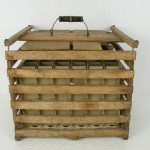 Grandma mailed us nine dozen fresh eggs fitted into a wooden frame of six layers, a wooden handle with address label at the top. Since these eggs had never been refrigerated, they could sit on our bedroom dresser for many weeks or until we ate them all up. We sent the empty frame back to be re-filled. In the fall when the eggs were large, they sometimes cracked from being over-sized. In the spring when the eggs were smaller, the sometime cracked from rattling around in the frame. I lost twenty pounds that fall, walking a mile and a half to class every day, eating eggs and vegetables.
Grandma mailed us nine dozen fresh eggs fitted into a wooden frame of six layers, a wooden handle with address label at the top. Since these eggs had never been refrigerated, they could sit on our bedroom dresser for many weeks or until we ate them all up. We sent the empty frame back to be re-filled. In the fall when the eggs were large, they sometimes cracked from being over-sized. In the spring when the eggs were smaller, the sometime cracked from rattling around in the frame. I lost twenty pounds that fall, walking a mile and a half to class every day, eating eggs and vegetables.
Chickens are sociable creatures and need their companions, both feathered and human. They talk about everything, arguing about who gets to lay an egg, “honey, move over, it’s my turn now.” Or announcing the laying of an egg. Perhaps it hurts a little so the cry is a complaint. They move on quickly.
 Akana, the bereft hen, loved her Alicia and sat on her shoulder. She lets me pick her up, stroke her and comes when I call. I have a couple scars on my arm where a chicken has tried to ride along as I walk around the garden, missed the perch, leaving a mark. My big Norwegian Forest cat lies in the lawn in the midst of them. Chickens have no fear of cats. Picture yourself looking up into that yellow eye past that sharp beak and you will understand. A cat doesn’t have a chance.
Akana, the bereft hen, loved her Alicia and sat on her shoulder. She lets me pick her up, stroke her and comes when I call. I have a couple scars on my arm where a chicken has tried to ride along as I walk around the garden, missed the perch, leaving a mark. My big Norwegian Forest cat lies in the lawn in the midst of them. Chickens have no fear of cats. Picture yourself looking up into that yellow eye past that sharp beak and you will understand. A cat doesn’t have a chance.
I have thanked four chickens for being part of my life, serving as providers of eggs and as exquisite lawn art, before killing and butchering them. Three were chicks that became crowing roosters. (Whoever earns their living sexing chickens has about a 20% failure ratio which seems pretty bad averages to me.) The fourth was a hen who became the punching bag for the others in the coop, the tortured lowest girl on the pecking order. The advice I got from the Seattle Farm Coop people was “to take the weakest one”. In the hen house, you do not punish the bully. You remove the bullied. That was the saddest sacrifice I have had to make.
Akana is getting along with my other hens better every day. I have given them free  range in the garden. Space makes for peaceful co-existence. But once they are in the coop, peace is replaced by gang warfare. The happy ending comes at night when they bury the hatchet and settle in close together on the roost high up against the roof, clucking companionably. All will be well. All manner of things will be well.
range in the garden. Space makes for peaceful co-existence. But once they are in the coop, peace is replaced by gang warfare. The happy ending comes at night when they bury the hatchet and settle in close together on the roost high up against the roof, clucking companionably. All will be well. All manner of things will be well.
Back yard hens are a wonderful part of life, slowing down the pace. Watching them is as entertaining as any sitcom on TV. Observing their scratch and peck slow march around the edge of the garden is a lesson is “slow and steady gets the job done.” 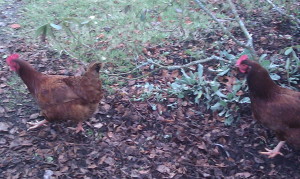 Reading other bloggers write about the marvelous lessons of chickens does not change my opinion that our chicken clichés describe how animalistic our lives can be. We can be “cooped up”, suffer from a “pecking order”, “run around like a chicken with her head cut off”, be “hen pecked” by a boss or a spouse, and woe be to the person who forgets: “don’t count your chickens before they are hatched.” What is painful in the hen house is painful in our own lives. Three cheers for the writer who finds “lions lying down with lambs” in her backyard. It is not happening that way with my backyard chickens. They make me laugh at how seriously we take our squabbles and one-up-man-ship. That is about the best I can do.
Reading other bloggers write about the marvelous lessons of chickens does not change my opinion that our chicken clichés describe how animalistic our lives can be. We can be “cooped up”, suffer from a “pecking order”, “run around like a chicken with her head cut off”, be “hen pecked” by a boss or a spouse, and woe be to the person who forgets: “don’t count your chickens before they are hatched.” What is painful in the hen house is painful in our own lives. Three cheers for the writer who finds “lions lying down with lambs” in her backyard. It is not happening that way with my backyard chickens. They make me laugh at how seriously we take our squabbles and one-up-man-ship. That is about the best I can do.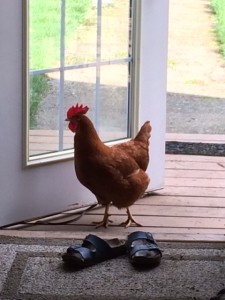
Be well, Do well and Keep Moving,
Betsy
206 933 1889
